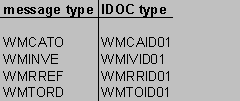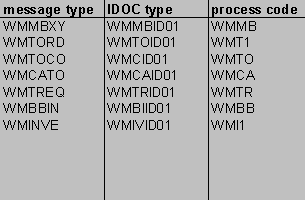Add the relevant logical systems to list. This is simply a logical name to be determined by you. Normally there is a default logical system name for each client, so this may already be defined, meaning you only have to create a logical system name for your subsystem.
To determine what the default name for your client is use transaction SCC4. Double click on your client number to see the logical name associated with it.
2. Define message types
Transaction: BD64
Enter the logical system which you created (or if it was already created, the one you found using transaction SCC4) in 1 above for your Client.
Enter the customer model. (If you donít know what this is then choose SUBSYSTEMS)
Choose Execute
Select the Logical System added for the Subsystem(SHIPCO)
Create message type and transfer the following message types:
WMBBIN, WMCATO, WMINFO, WMINVE, WMMBXY, WMRREF, WMSUMO, WMTOCO, WMTORD, WMTREQ.
3. Define RFC destination
3.1 destination definition
Transaction: SM59
Place cursor on TCP/IP connection and click Create
3.1.1 give the destination a name. (SHIPCO)
connection type: T for TCP/IP
3.1.2 Hit enter button to bring you to the technical settings screen.
3.1.3 Choose "sh_srv1.shp_reg" as the Program ID. This is the ID used by Loglink to register itself with SAP


